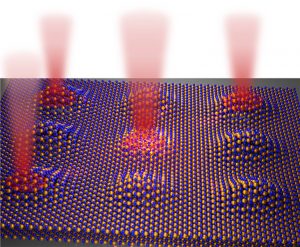By Wayne Gillam | UW ECE News

An illustration of an array of single-photon emitters (also known as “quantum emitters”) developed by the UW research team. These emitters are a critical component for quantum technologies based on light and optics. In the illustration, the blue and gold dots represent two layers of tungsten and selenium atoms, and each raised bump is the location of what is called a “strain-induced quantum dot.” The research team used these quantum dots to create the quantum emitters, which can be selectively activated to generate photons and mechanical vibrations between the atomic layers, which in turn can be used to encode and transmit quantum information. The four red triangles represent light emitted from four quantum emitters — each generating one photon at the same energy level as the others. Illustration provided by Ruoming Peng
A UW research team, led by UW ECE and Physics Professor Mo Li, has found a way to leverage the “breathing,” or mechanical vibration, between two layers of atoms, engineering a new building block for quantum technologies.
The act of breathing is primal. People breathe, animals breathe, and in a certain sense, plants and even non-living things such as oceans and the Earth itself demonstrate their own types of respiration processes. Big and small, natural systems that breathe, or exhibit behavior strikingly similar to breathing, can be found throughout the world. So, with that in mind, it should be no surprise that this sort of “breathing” phenomena also takes place on the atomic level.
Recently, a University of Washington research team discovered that they could detect atomic “breathing,” that is, the mechanical vibration between two layers of atoms, by observing the type of light those atoms emitted when stimulated by a laser. The group’s discovery will allow them to use the sound of this atomic “breath” to encode and transmit quantum information. And because of that, a device developed by the team could serve as a new type of building block for quantum technologies, which are widely anticipated to have many future applications in fields such as computing, communications, and sensor development.
The cross-departmental team was led by Mo Li, who is a professor and the associate chair for research in the UW Department of Electrical & Computer Engineering (UW ECE). Li holds a joint appointment with the physics department, is a member of the steering committee for QuantumX, and is a faculty member of the Institute for Nano-Engineered Systems. He noted that this research aimed to provide scientists and engineers with a new resource for developing quantum computing circuitry.
“This is a new, atomic-scale platform, using what the scientific community calls ‘optomechanics,’ in which light and mechanical motions are intrinsically coupled together,” Li said. “It provides a new type of involved quantum effect that can be utilized to control single photons running through integrated optical circuits for many applications.”
Li and his colleagues described this quantum platform in detail in a paper recently published in Nature Nanotechnology. The interdisciplinary UW research team included graduate students, postdoctoral scholars and professors from electrical and computer engineering, physics, and materials science and engineering.
A hybrid platform for quantum computing

The UW research team included Adina Ripin (left), lead author of the study and a doctoral student in the physics department, Ruoming Peng (center), co-lead author and a recent UW ECE graduate (Ph.D. ‘22), and senior author Mo Li (right), a professor in UW ECE and the physics department and the UW ECE associate chair for research.
This research grew from previous work by the Mo Li Group on a quantum-level quasiparticle called an “exciton.” This quasiparticle is important because information can be encoded into an exciton and then released from it in the form of a photon — a tiny particle of energy considered to be the quantum unit of light. Quantum properties of each photon emitted (such as the photon’s polarization, wavelength and/or emission timing) can function as a quantum bit of information, or “qubit,” for quantum computing and communication. And because this qubit is carried by a photon, it travels at the speed of light.
“The bird’s-eye view of this research is that to feasibly have a quantum network, we need to have ways of reliably creating, operating on, storing and transmitting qubits,” said Adina Ripin, a lead author of the paper, member of the Mo Li Group, and a doctoral student in the physics department. “Photons are a natural choice for transmitting this quantum information because optical fibers enable us to transport photons long distances at high speeds, with low losses of energy or information.”
The research team worked with excitons with the aim of creating a single photon emitter, or “quantum emitter,” which is a critical component for quantum technologies based on light and optics. Prevailing quantum emitters in the field often use defects in atomic lattices (such as those found in pink-colored diamonds) as a source for photon emission; however, scientists and engineers who create a quantum emitter in this manner can be at the mercy of wherever the defects happen to occur naturally in the lattice. By contrast, the UW team wanted to be able to determine exactly where the quantum emitter would be located within its supporting material.
To do this, the team used two extremely thin layers of tungsten and selenium atoms, known as tungsten diselenide, and placed one layer on top of the other. These layers are so thin — each is only one atom thick — that for practical purposes, they are considered two-dimensional.
“Two-dimensional quantum materials such as this are really interesting systems for storing quantum information because the reduced dimensionality of the material leads to many unique quantum states that are extremely stable,” Ripin explained.
The team pressed the two layers of tungsten diselenide onto a substrate, prepared with hundreds of microscopic pillars, each only 200 nanometers wide. The atomic layers draped over these nanopillars, which created a slight strain in the material. The tension at the site of each nanopillar produced what is known as a “strain-induced quantum dot.” It is these quantum dots that isolated excitons within a confined space and allowed the team to create the quantum emitter on the substrate exactly where they desired.
By applying a precise pulse of laser light, the team was able to knock a tungsten diselenide atom’s electron away from the nucleus, which generated an exciton quasiparticle. Each exciton the team produced consisted of a negatively charged electron on one layer of the tungsten diselenide and a positively charged hole where the electron used to be on the other layer. And because opposite charges attract each other, the electron and the hole in each exciton were tightly bonded to each other. After a short moment, as the electron dropped back into the hole it previously occupied, the exciton emitted a single photon encoded with quantum information — producing the quantum emitter the team sought to create.
Phonons as a resource for transmitting quantum information
In the midst of their research, the team discovered that the tungsten diselenide atoms were emitting more than photons and excitons. The atoms were also producing another type of quasiparticle, known as a phonon. Phonons are a product of atomic vibration, which occurs in all matter in a natural process akin to breathing — think of the phonon as the sound of the “breath” between atoms. In this context, the phonons were generated by the vibration between the two atomic layers of the tungsten diselenide, which acted like tiny drumheads vibrating relative to each other. In general, phonons can be thought of as quantum-level sound waves, conceptually similar to photons being quantized light waves.
This was the first time phonons have ever been observed in a single photon emitter in such a two-dimensional atomic system. When the team measured and examined the spectrum of the emitted light, they noticed several intriguing and equally spaced peaks. And thanks to expert analysis from team member Ting Cao, a quantum theorist and an assistant professor in materials science and engineering, they soon discovered that every single photon emitted by an exciton was coupled with one, two, three or more phonons. This is somewhat akin to climbing a quantum energy ladder one rung at a time, and on the spectrum, these energy spikes were represented visually by the equally spaced peaks.
“A phonon is the natural quantum vibration of the tungsten diselenide material, and it has the effect of vertically stretching the exciton electron-hole pair sitting in the two layers,” Li explained. “This has a remarkably strong effect on the optical properties of the photon emitted by the exciton that has never been reported before.”
The team was inspired by their discovery to generate ideas for harnessing the phonons for quantum technology. Through applying electrical voltage, they found that they could vary the interaction energy of the associated phonons and emitted photons. These variations were measurable and controllable in ways relevant to encoding quantum information into a single photon emission. And this was all accomplished in one integrated system — a device that involved only a small number of atoms.
“I find it fascinating that we were able to observe a new kind of hybrid quantum platform,” said Ruoming Peng, who was also a lead author of the paper and graduated with his doctoral degree from UW ECE in 2022. “By studying the way phonons interact with quantum emitters, we discovered a whole new realm of possibilities for controlling and manipulating quantum states. This could lead to even more exciting discoveries in the future.” Peng is now a postdoctoral researcher at the University of Stuttgart in Germany and plans to continue research in similar quantum systems.
Next steps for the research team will include building a waveguide — fibers on a chip that catch single photon emissions and direct them where they need to go — and scaling up the system. Instead of controlling only one quantum emitter at a time, the team wants to be able to control multiple emitters and their associated phonon states. This will enable the quantum emitters to “talk” to each other, building a solid base for quantum circuitry.
“Our overarching goal is to create an integrated system with quantum emitters that can use single photons running through optical circuits and the newly discovered phonons to do quantum computing and quantum sensing,” Li said. “This advance certainly will contribute to that effort, and it helps to further develop quantum computing, which, in the future, will have many applications.”
Adina Ripin, Ruoming Peng, Xiaowei Zhang, Srivatsa Chakravarthi, Minhao He, Xiaodong Xu, Kai-Mei Fu, Ting Cao, and Mo Li are authors of “Tunable phononic coupling in excitonic quantum emitters,” which is the research paper described in this article. Learn more at the Mo Li Group website, or contact Mo Li for more information. This research is supported by the National Science Foundation through the Molecular Engineering Materials Center (MEM-C) at the UW. Adina Ripin is also supported by the NSF Graduate Research Fellowship Program.

